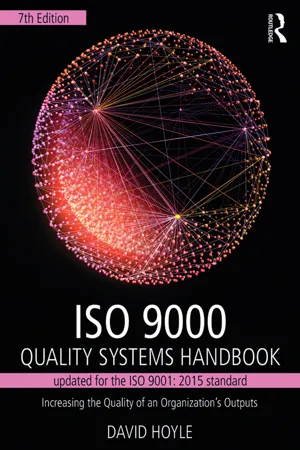
ISO 9000 Quality Systems Handbook-updated for the ISO 9001: 2015 standard
Increasing the Quality of an Organization's Outputs
David Hoyle
- 874 páginas
- English
- ePUB (apto para móviles)
- Disponible en iOS y Android
ISO 9000 Quality Systems Handbook-updated for the ISO 9001: 2015 standard
Increasing the Quality of an Organization's Outputs
David Hoyle
Información del libro
Completely revised to align with ISO 9001: 2015, this handbook has been the bible for users of ISO 9001 since 1994, helping organizations get certified and increase the quality of their outputs.
Whether you are an experienced professional, a novice, or a quality management student or researcher, this is a crucial addition to your bookshelf. The various ways in which requirements are interpreted and applied are discussed using published definitions, reasoned arguments and practical examples. Packed with insights into how the standard has been used, misused and misunderstood, ISO 9000 Quality Systems Handbook will help you to decide if ISO 9001 certification is right for your company and will gently guide you through the terminology, requirements and implementation of practices to enhance performance.
Matched to the revised structure of the 2015 standard, with clause numbers included for ease of reference, the book also includes:
-
- Graphics and text boxes to illustrate concepts, and points of contention;
-
- Explanations between the differences of the 2008 and 2015 versions of ISO 9001;
-
- Examples of misconceptions, inconsistencies and other anomalies;
-
- Solutions provided for manufacturing and service sectors.
This new edition includes substantially more guidance for students, instructors and managers in the service sector, as well as those working with small businesses.
Don't waste time trying to achieve certification without this tried and trusted guide to improving your business – let David Hoyle lead you towards a better way of thinking about quality and its management and see the difference it can make to your processes and profits!
Preguntas frecuentes
Información
Part 1
Introduction
Introduction to Part 1
- The organization already exists; it is delivering services and providing products and services to customers, but getting quite a few complaints so it’s becoming difficult to compete on quality. It is making a profit but not enough to invest for the future because the managers spend a lot of time firefighting instead of improving the efficiency and effectiveness of their processes. It’s doing what it can to comply with regulations but occasionally breaches employment laws and environmental legislation as it strives to balance competing objectives. No matter how many times problems are fixed, similar problems seem to arise again elsewhere, and often quick fixes lead to bigger problems much later.
- The organization already exists; it is delivering services and providing products and services to customers and mostly receiving compliments, but competition is tough. It is making enough profit to invest for the future because its managers are proactive, putting a lot of effort into ensuring risks to success are mitigated. Thus, this organization doesn’t need to spend much time firefighting and can instead pursue opportunities for improving the efficiency and effectiveness of its processes. By striving to satisfy customers in a way that meets the needs of the other stakeholders, it has found it can balance competing objectives and has not had compliance issues of any significance. When problems arise, managers tend not to go for the quick fix, but spend time ensuring that actions to prevent their recurrence won’t have adverse consequences later.
1
Putting ISO 9001 in context
Introduction
- What the issue is?
- Why it’s an issue?
- What it’s costing you?
- What you should do about it?
- What the impact of it will be?
- How much it will cost to improve performance so that these types of issues don’t recur?
- Where the resources are going to come from?
- When you need to act?
- What the alternatives are and their relative costs?
- What the consequences are of doing nothing?
- What ISO 9001 is intended to do, making the link between ISO 9000 and the fundamental basis for trade
- The process by which international standards are developed and the roles of the various groups involved
- Reasons for using ISO 9001 – the interdependent duo of capability and confidence
- The scope of ISO 9001 and what it means
- Applicability of ISO 9001 – why it’s difficult to rule anything out
- Design or assessment standard – the users’ choice
- ISO 9001 and the free movement of goods and services
- Popularity of ISO 9001 certification – some facts, figures and trends
- What accredited certification means and doesn’t mean